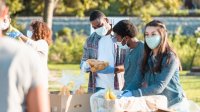How Community Service Supports Students in Tough Times
Giving struggling middle and high school students opportunities to help others may ease some of the stress they’re feeing this year.
Your content has been saved!
Go to My Saved Content.The pandemic has revealed, and in some cases exacerbated, mental health issues that many students deal with on a daily basis. As students have moved from complete isolation to sporadic interactions, the social and emotional implications surrounding the pandemic have led educators to think of creative ways to help students reacclimate to school and the community as a whole.
There are some students who have been completely isolated and attended school remotely since last March. Others have had little to no contact with their peers outside of school as well. This isolation—albeit necessary for safety—can have negative short- and long-term impacts for students of all ages. A recent study found a rise in anxiety and depression in children and adolescents during and after isolation.
Signs of Strain
There are many signs and symptoms of students struggling with mental health issues, including poor grades, poor attendance, facial expressions, body language, and substance abuse. Unfortunately, due to the pandemic and distance learning, some of these signs cannot be observed by educators as easily as they would otherwise. In some cases, students don’t turn on their cameras or are reluctant to participate in the remote setting. So the question many educators have been trying to answer is: What can we do to help our students struggling with mental health issues?
Educators have been finding creative ways to help students deal with the trauma that the pandemic has brought with it. Some of these strategies include weaving in social and emotional wellness as a daily part of lesson planning, and providing safe spaces in the buildings for those students who are reluctant to come back and reintegrate into their classrooms due to increased anxiety. Others have provided extended counseling sessions, one-on-one or in small groups. All of these strategies help those in need, but educators still need other avenues to help students who may be reluctant to return to in-person learning.
One successful method for helping students in need during the pandemic has been giving students opportunities to help others. Community service can provide many benefits that are often overlooked. According to the Mayo Clinic, community service:
- Decreases the risk of depression,
- Gives a sense of purpose and teaches valuable skills,
- Helps people stay physically and mentally active,
- Reduces stress levels, and
- Helps people meet other people and build relationships.
Supporting Students With Community Service
Community service can sometimes be the catalyst for getting students out of their homes and back into the school buildings. This very important first step can often be hard for students who have been physically and/or emotionally isolated for close to a year now. At my school, we’ve developed some ways for students to help others that are safe from the risk of spreading Covid.
We host a monthly community service session where students make sandwiches for a local food kitchen that serves those in need. Students get together, socially distanced, and help members of their community who are struggling. We play music and talk during the sessions, so there is a social component to the event.
Students are chosen for a variety of reasons to participate, but the groups remain small on purpose. The small size gives students a chance to talk to each other and get to know each other. The students also know that the sandwiches they make are immediately used by the local food kitchen.
Another opportunity we facilitated was to have students spend time with the elderly from local nursing homes on virtual platforms. We arranged the meetings, which typically lasted about a half an hour, and the students spent time talking with those who have also been negatively impacted by the pandemic and are often in isolation themselves from their families and visitors. This can either be done in the school building as a group or from a student’s home individually or in pairs online. This was another win-win opportunity for our struggling students to find purpose where purpose may not have previously existed and for the elderly to have the companionship of another human being. These relationships can be single serving, or they can be ongoing and developed over monthly or every other month meetings.
Lastly, another opportunity that we’ve presented students is packaging collected and donated food for local families. Just like the previous two, this is safe for students to do at school and provides a much needed sense of purpose by helping others. These activities can be done periodically around the holidays or on an ongoing basis every other week.
By offering these opportunities to students who are struggling, we have found that some have come back to our building to help. This has sometimes translated into those students attending more classes and returning to school and integrating back with their peers. And while the community service efforts weren’t the secret for all kids, some students did find themselves more engaged in classes or even returning in person after a few sessions. This endeavor is still in its infancy, so this is merely observational data. However, my gut is telling me that this will be an important tool moving forward to help kids deal with the adverse effects of the pandemic.
Regardless of the activity, giving students opportunities to help other people can be a great starting place for struggling students. It can be the first or final step in getting a student to reacclimate to the school community and feel good about themselves.
